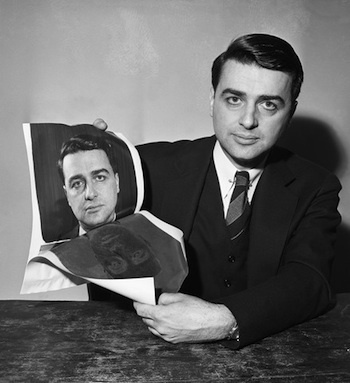Search Database

Born in Bridgeport, Connecticut on May 7, 1909, Edwin Herbert Land's fascination with polarizing light developed at an early age. After attending Norwich Academy, he became a student at Harvard University. So consuming was Land's preoccupation with polarization that he created a laboratory in his home to supplement what he was learning in the classroom. At the age of 20, he applied for a patent for a polarizer that looked like a glass sheet, which he described as the Polaroid J sheet, and in 1932, he announced his solution for polarizing light at a Harvard conference that could be both inexpensive to produce and easily manufactured.
Taking repeated leaves of absence from college to focus exclusively on his polarizing experiments, Mr. Land never received his undergraduate degree from Harvard. In collaboration with Harvard physics professor George Wheelwright III, Mr. Land opened the Land-Wheelwright Laboratories, and the duo found a receptive market for their products with the Eastman Kodak Company. In 1937, the partners formed the Polaroid Corporation, which initially produced polarized materials. During the Second World War when military applications reached their zenith, their business skyrocketed, and Polaroid expanded its production operations to include research and development. It was the leading military supplier of goggles, filters, periscope filters, light-polarizing products for aerial reconnaissance missions, and rifle sights. Mr. Land's "H-sheet" light polarizer, which remains the most commonly used light polarizer. His polarizers had a wide variety of civilian uses as well - in airplane windows, camera filters, scientific instruments, and even polarizing sunglasses, to name a few.
Edwin Herbert Land's most famous invention was the result of his three-year-old daughter's question as to why she was unable to see a picture immediately after it was taken. He conceptualized a camera with film that could be developed within a minute. The Polaroid Land Camera was released in 1947, and by 1963, it was capable of taking both black and white and color pictures. Its unprecedented commercial success made the Polaroid Corporation one of the most successful post-World War II companies. The camera continued to evolve, and by 1972, the SX-70 Polaroid camera could take a completely developed laminated photograph within sixty seconds.
Never content to rest on his laurels, Mr. Land shifted his focus to making instant movies, a project he began in the 1950s at the height of the 3-D craze. His Polavision instant movie system, which was considered a major technological advancement during the 1970s, was one of Mr. Land's rare commercial failures. However, he successfully applied the technology to the production of Polachrome instant 35-mm slides. Mr. Land's experiments with color optics led to his landmark Retinex color vision theory, which argues that the ways in which the retina and cortex formulate the red, green, and blue lightnesses of an image actually determines the color of the image.
Although never a college graduate himself, Mr. Land actively promoted the importance of receiving a college education. He was a lecturer at his old alma mater, Harvard University, and in later years was a professor at the Massachusetts Institute of Technology. He received a well-earned induction into the National Inventors Hall of Fame in 1977, and later received the Medal of Freedom, the highest honor awarded to an American civilian. He received more than 500 patents for his inventions before officially retiring as CEO of the Polaroid Corporation in 1980. Mr. Land devoted much time in later years to the Rowland Institute of Science he founded in 1960. Edwin Herbert Land, the pioneer of polarized light died on March 1, 1991 at the age of 81.
Ref:
1978 Instant Image: Edwin Land and the Polaroid Experience. (New York: Stein & Day).
1994 Memorial Tributes: National Academy of Engineering (Washington, DC: National Academy Press), pp. 129-133.
1996 Biographical Dictionary of the History of Technology (London: Routledge), pp. 715-716.
1999 Insisting on the Impossible: The Life of Edwin Land. (New York: Perseus).
2011 The Britannica Guide to Sound and Light (New York: Britannica Educational Publishing), pp. 307-309.
# 1787
2012-03-25 06:08:39
Copyright © 2002 - 2022 Historic Camera